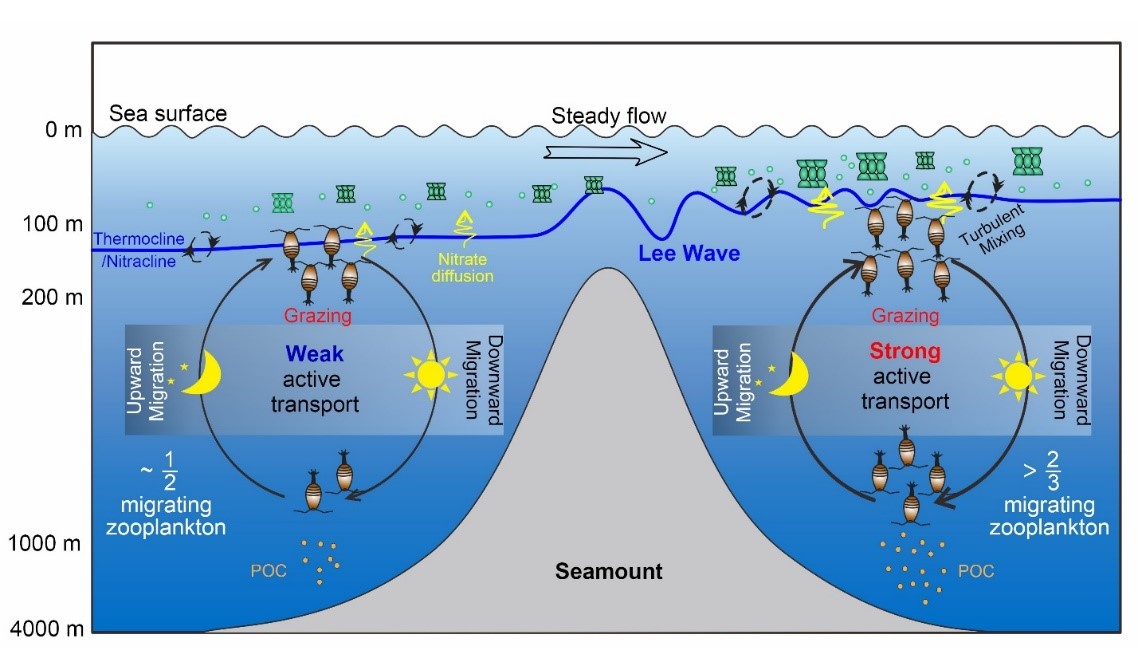Newsphoto
In June, the Marine Biogeochemistry Research Team of the Key Laboratory of Marine Ecosystem Dynamics, MNR of the SIO made significant progress in the study of the formation mechanism of seamount ecosystems. The related findings were published in Science Advances under the title “Seamounts Generate Efficient Active Transport Loops to Nourish the Twilight Ecosystem”. This research, based on the comprehensive field observation data of physics, chemistry and biology, revealed for the first time that when oligotrophic sea currents flow through seamount topography, they drive the formation of high biomass, high-intensity plankton diurnal migration, and efficient organic matter export processes in the euphotic layer downstream of seamounts. This study provides new insights into the formation mechanism of seamount ecosystems, indicating that, unlike short-term, transient and moving production increase caused by mesoscale eddies, seamounts, by standing in fixed positions, can sustainably promote phytoplankton blooms and efficient organic matter export, nourishing the deep-sea and benthic ecosystems of seamounts, thus forming a three-dimensional ecological oasis linking the euphotic layer and the deep sea. The first author of the paper is Wang Xinyang, a jointly trained doctoral student of the SIO and Shanghai Jiao Tong University. The corresponding authors are Researcher Chen Jianfang and Researcher Li Hongliang from the SIO. The co-authors include Associate Researcher Zhang Jingjing, Researcher Zhang Dongsheng, and Researcher Xie Xiaohui from the SIO, as well as Professor Xie Wei and Professor Yin Kedong from Sun Yat-sen University, Professor Diana Ruiz-Pino from Sorbonne University, and Professor Gao Shuji from Hainan University. Nearly half of the world’s seamounts are distributed in oligotrophic “oceanic deserts”. They nurture abundant fisheries resources and benthic organisms, and provide habitats for numerous species, making them “ecological oases” in the ocean. Traditional seamount productivity theories suggest that the complex hydrodynamic processes in seamount areas promote nutrient supply and primary production responses within the euphotic layer, known as the “seamount effect”. However, it remains unclear whether the organic matter produced in this process can be transferred through the food web to higher trophic levels and whether it provides energy and material sources for deep-sea ecosystems. To address this issue, this study focused on the main line of flow field, topography, upper-level primary production, and organic matter export, conducting a multidisciplinary integrated investigation into the biogeochemical process in the upper layers of seamounts. The research team used the self-integrated multi-parameter biochemical profiler, including Conductivity-Temperature-Depth profiler (CTD), in-situ ultraviolet nitrate analyzer (Deep SUNA), fluorescence sensor, and underwater video profiler (UVP), to obtain spatiotemporal variations in the hydrodynamic environmental parameters, nutrient content and diffusion flux, phytoplankton biomass, copepod zooplankton biomass, and particulate organic carbon (POC) export flux in the Xianbei Seamount in the South China Sea. The results showed that the coupled effects of downstream flow field, topography, and ecology of the seamount created an efficient pathway for organic matter from production to export, namely the “active export loop” mediated by diurnal migration and feeding of zooplankton. These continuously rapid exports of organic matter may serve as a fresh food source for deep-sea ecosystems. The study extended the results to the North Pacific Subtropical Gyre (NPSG) and estimated the contribution of seamounts to organic carbon export. The results showed that although shallow seamounts (<208 meters) only accounted for 0.74% of the NPSG area, they contributed 2.1-3.8% of the organic matter export flux in this area. This further emphasizes the higher biological pump export efficiency of seamounts in oligotrophic marine areas, highlighting their irreplaceable role in marine biological connectivity and fisheries resources. The study extended the results to the North Pacific Subtropical Gyre (NPSG) and estimated the contribution of seamounts to organic carbon export. The results showed that although shallow seamounts (<208 meters) only accounted for 0.74% of the NPSG area, they contributed 2.1-3.8% of the organic matter export flux in this area. This further emphasizes the higher biological pump export efficiency of seamounts in oligotrophic marine areas, highlighting their irreplaceable role in marine biological connectivity and fisheries resources.



